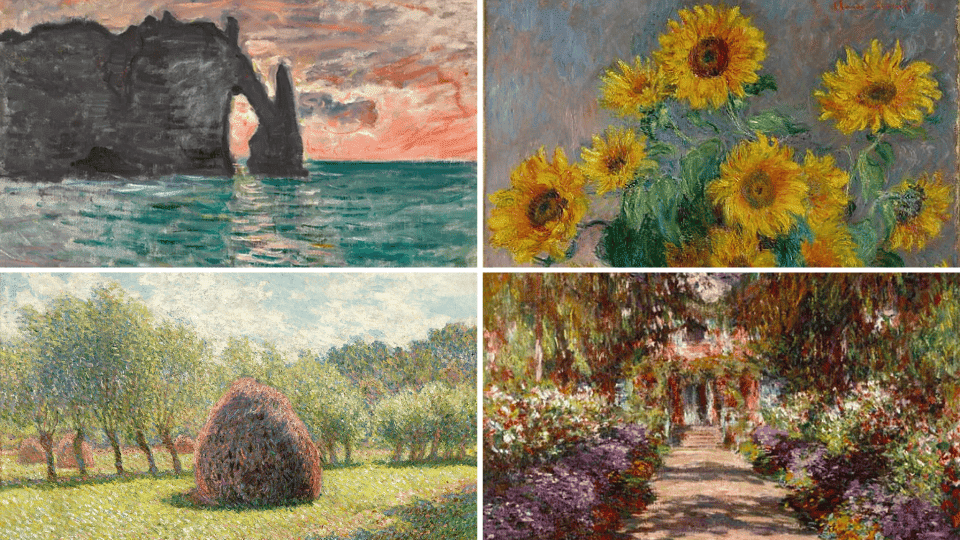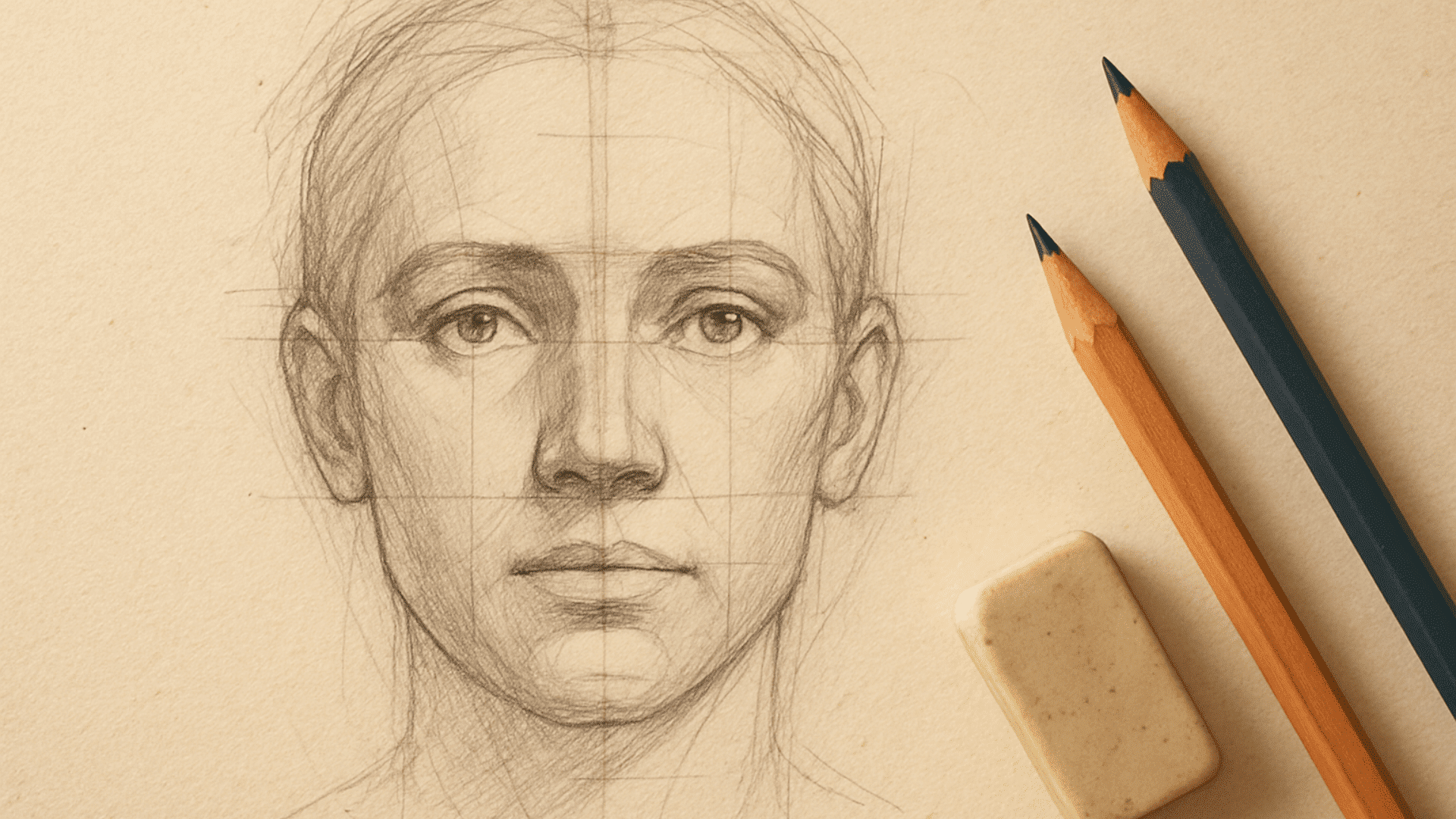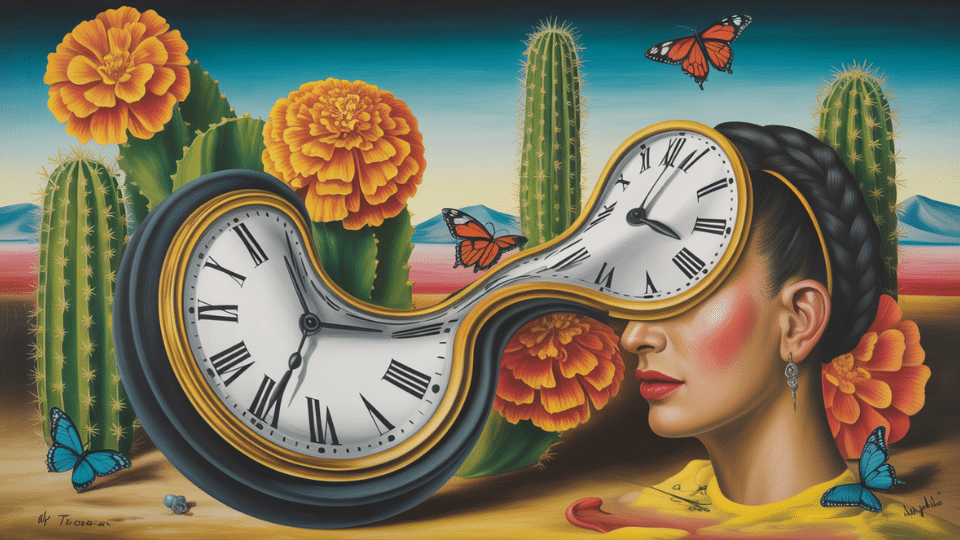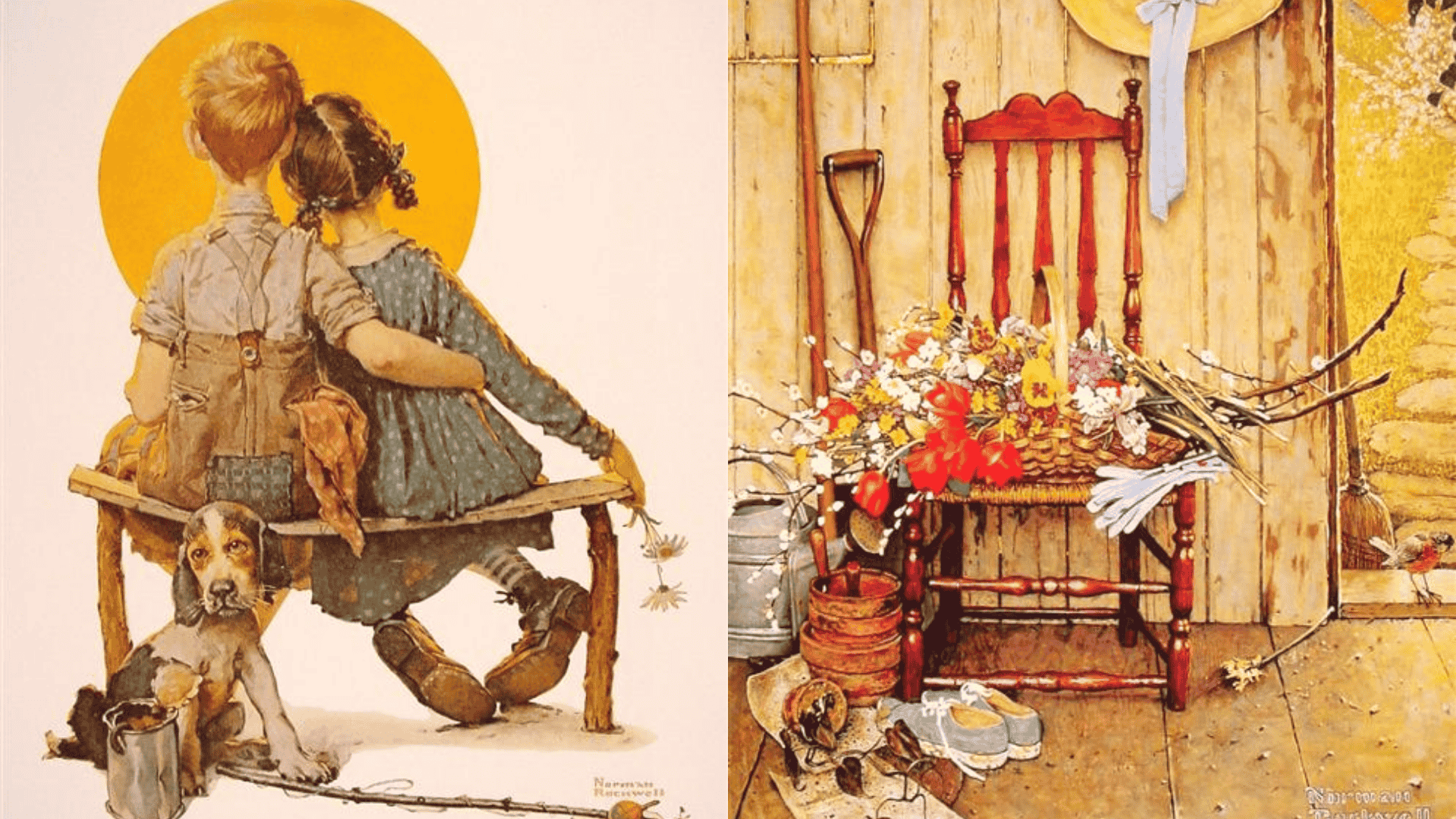Have you ever wondered why certain paintings feel like you’re stepping into a dream? Claude Monet’s famous paintings have that effect on people; they blur the lines between reality and imagination.
The French artist didn’t just paint what he saw; he captured how light danced across water, how colors shifted through the day, and how ordinary scenes could feel magical.
While water lilies made him famous, Monet’s other works reveal his true genius. Let’s find what makes them unforgettable.
Who Was Claude Monet?
Claude Monet (1840–1926), a French painter from Paris, revolutionized Western art. Initially trained in traditional techniques, he became frustrated with academic rules and began painting outdoors, capturing the shifts its natural light.
In 1872, Monet painted “Impression, Sunrise,” depicting a hazy Le Havre harbor at dawn. When displayed in 1874, an art critic mocked it as a mere “impression” rather than a finished work.
Monet and his fellow artists adopted the term, launching the Impressionist movement and making Monet one of its founding fathers.
Throughout his 60-year career, Claude Monet’s famous paintings of water lilies, gardens, and landscapes established him as one of the most influential artists in history.
The Most Famous Claude Monet Paintings
Monet’s extraordinary body of work spans over six decades, with certain paintings standing out as defining masterpieces that capture his genius for changing light, color, and everyday scenes into evergreen art.
1. Impression, Sunrise
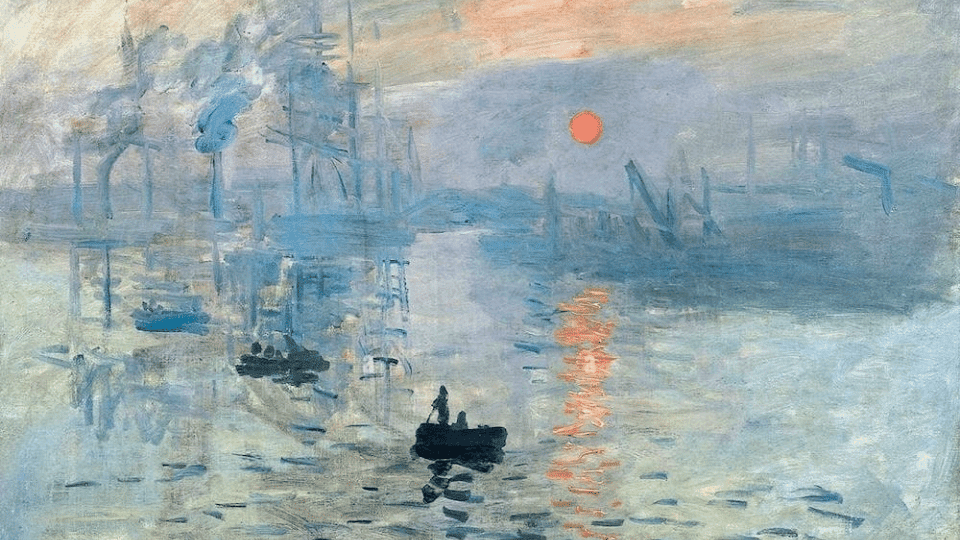
This iconic painting depicts the port of Le Havre at dawn, with the sun casting an orange glow over misty waters. Small boats and industrial cranes appear as shadowy silhouettes against the hazy morning atmosphere.
Monet used loose, visible brushstrokes and a limited color palette to capture the atmospheric quality of early morning fog, prioritizing immediate visual impression over photographic accuracy.
- Year: 1872
- Significance: This work gave the Impressionist movement its name after critic Louis Leroy mockingly used the title in his 1874 review. It is one of art history’s most influential paintings
2. Water Lilies Series

Monet created approximately 250 oil paintings of water lilies from his carefully cultivated garden pond in Giverny, spanning the last three decades of his life.
The series became an obsessive learning of light, reflection, and color, with many paintings massive in scale and designed to surround viewers.
- Year: 1896-1926
- Significance: The famous panels at Musée de l’Orangerie occupy two oval rooms, creating an immersive experience. The series traces Monet’s evolution and influences generations of abstract expressionists.
3. Woman with a Parasol
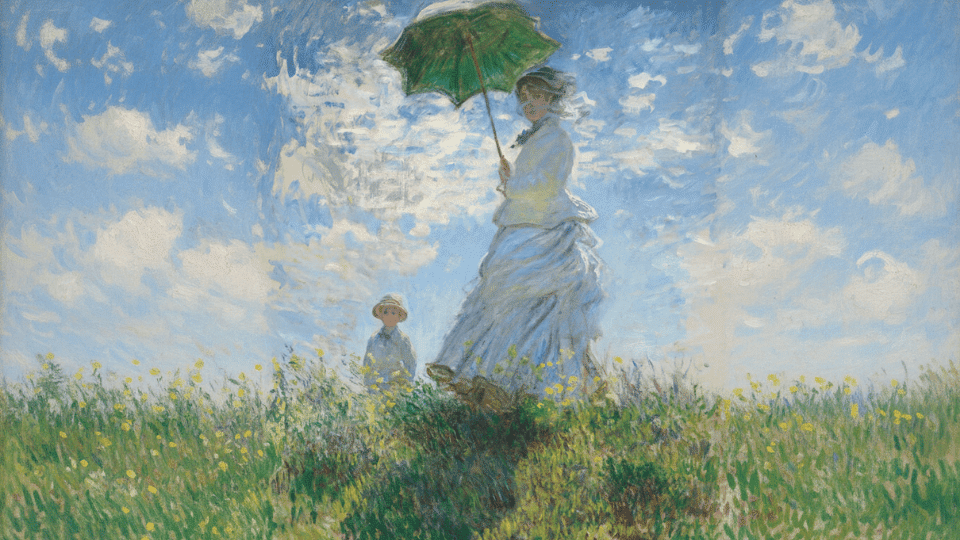
This painting depicts Monet’s first wife, Camille, and their son, Jean, standing on a hillside on a breezy summer day, with Camille’s dress and veil fluttering in the wind.
The low viewpoint creates a dramatic composition with the figures silhouetted against a cloudy blue sky. Monet painted this work quickly in natural light, with dappled sunlight and shadow patterns showcasing his interest with fleeting light conditions.
- Year: 1875
- Significance: The painting exemplifies the Impressionist commitment to plein air painting and capturing spontaneous moments
4. The Japanese Bridge
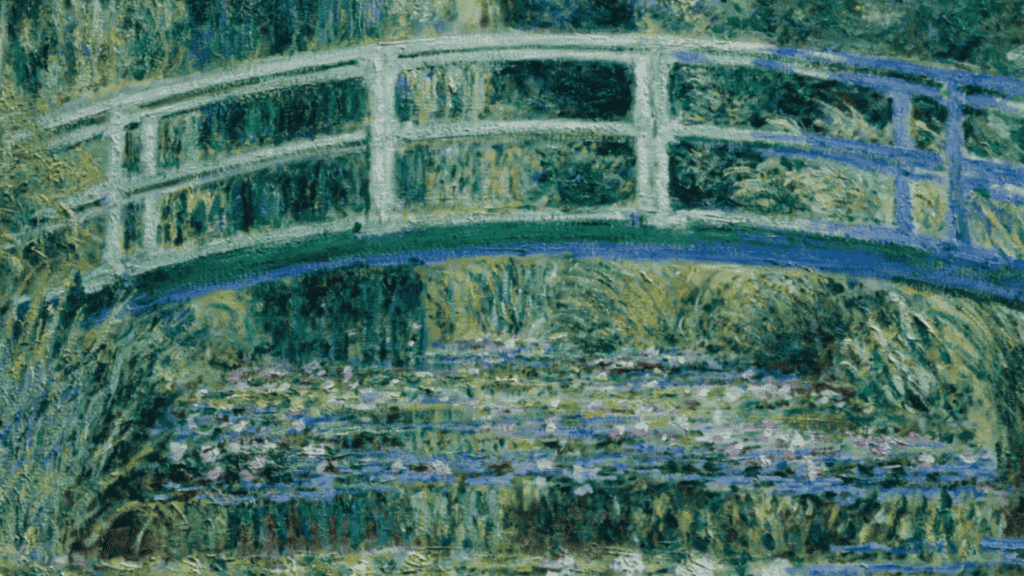
Monet painted his wooden footbridge at Giverny multiple times, inspired by Japanese woodblock prints he collected.
The bridge arches over his water lily pond, surrounded by lush greenery and dangling wisteria vines, demonstrating his fascination with reflections.
- Year: 1899
- Significance: The composition represents the artist’s personal sanctuary and symbolizes his successful blend of Eastern and Western artistic influences, becoming one of his most recognizable and iconic motifs.
5. Houses of Parliament, London Series
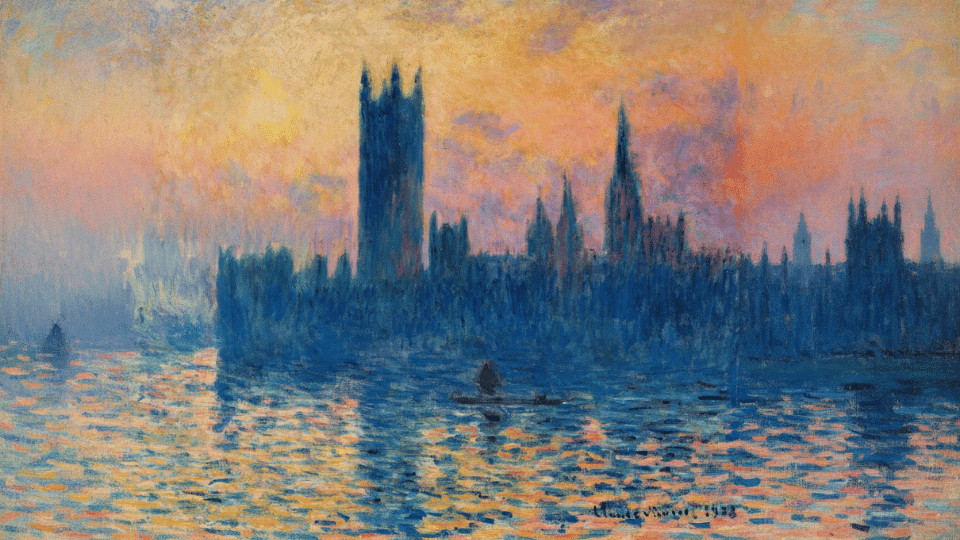
Monet created over 100 paintings of London’s Palace of Westminster during three trips to the city, working from a terrace at St. Thomas’ Hospital.
He captured the Gothic building through varying fog and light conditions, with each painting showing dramatically different atmospheres.
- Year: 1900-1904
- Significance: The series demonstrates Monet’s commitment to painting the same subject under changing conditions to find perception, proving that atmosphere and light could be more important than the architectural subject itself.
6. The Artist’s Garden at Giverny
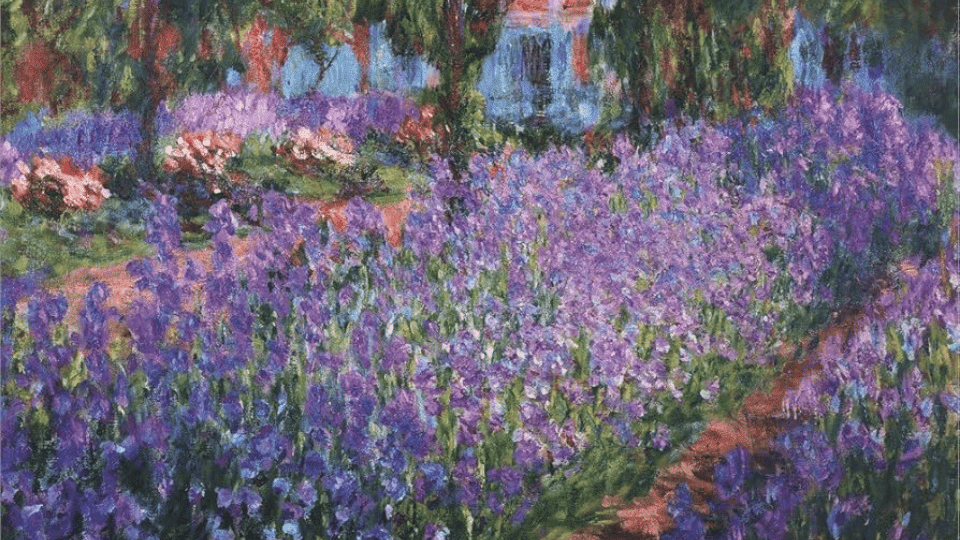
This painting showcases the flower-filled pathways of Monet’s beloved garden, which he designed and tended himself, with vibrant masses of irises creating a purple river through the composition.
Monet’s brushwork here is energetic and dense, with flowers rendered as patches of pure color rather than botanical details.
- Year: 1900
- Significance: The painting reflects how Monet turned his property into both his greatest inspiration and his most enduring artwork, with the garden serving as his living canvas and personal retreat.
7. Rouen Cathedral Series

Monet painted over 30 views of Rouen Cathedral’s west facade, working from a rented room across the street to capture the Gothic architecture at different times of day.
Rather than focusing on architectural details, he depicted the cathedral as a screen for shifting patterns of light and shadow.
- Year: 1892-1894
- Significance: The series influenced abstract artists decades later as the cathedral’s form nearly dissolves into patches of color and texture
8. San Giorgio Maggiore at Dusk
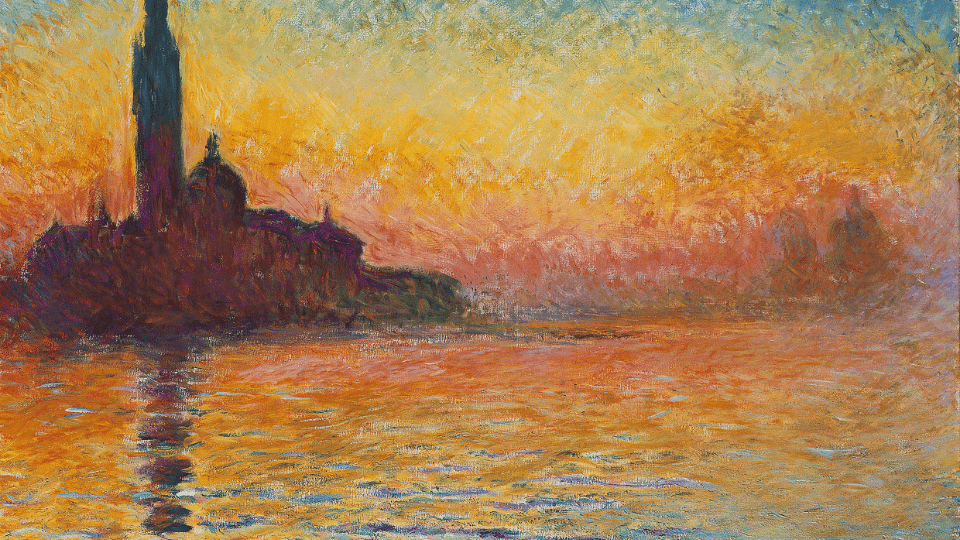
Monet visited Venice in 1908 and created several paintings of the island church of San Giorgio Maggiore, with this twilight scene bathing the Renaissance church in soft, atmospheric light.
The building and its bell tower appear as silhouettes against a luminous sky, with colors ranging from peach to lavender.
- Year: 1908-1912
- Significance: The looser brushwork demonstrates Monet’s continued evolution toward more abstract, atmospheric painting in his later years, with the architecture almost dissolving into light and water to capture Venice’s legendary beauty.
9. Poppies
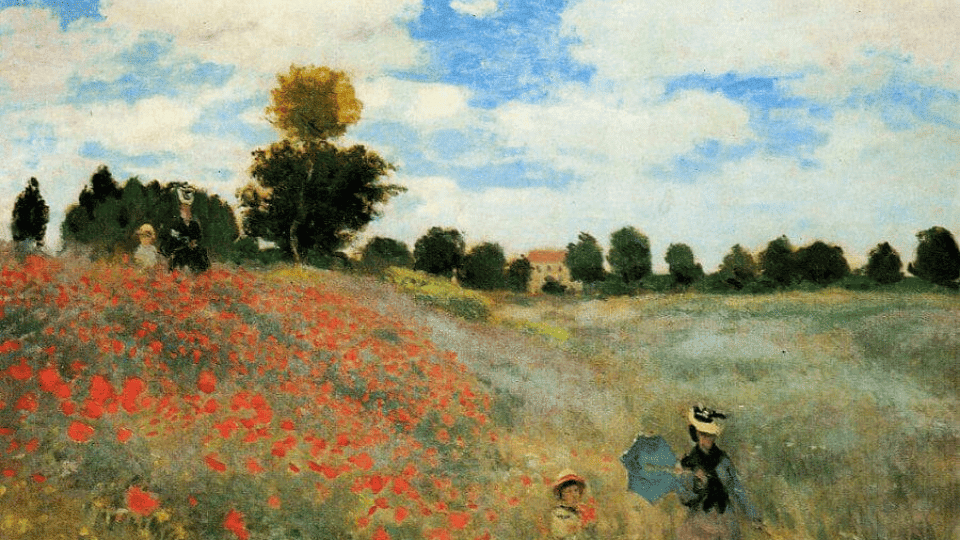
This joyful painting depicts a poppy field near Argenteuil, with Camille and Jean Monet appearing twice in the composition, suggesting the passage of time and movement through the landscape.
Brilliant red poppies scatter across rolling green hills under a partly cloudy sky, embodying the essence of French countryside summer.
- Year: 1873
- Significance: Exhibited in the 1874 Impressionist exhibition, this work helped establish the movement’s revolutionary approach and remains a beloved example of Impressionism’s ability to capture simple, unguarded moments
10. The Cliff Walk at Pourville
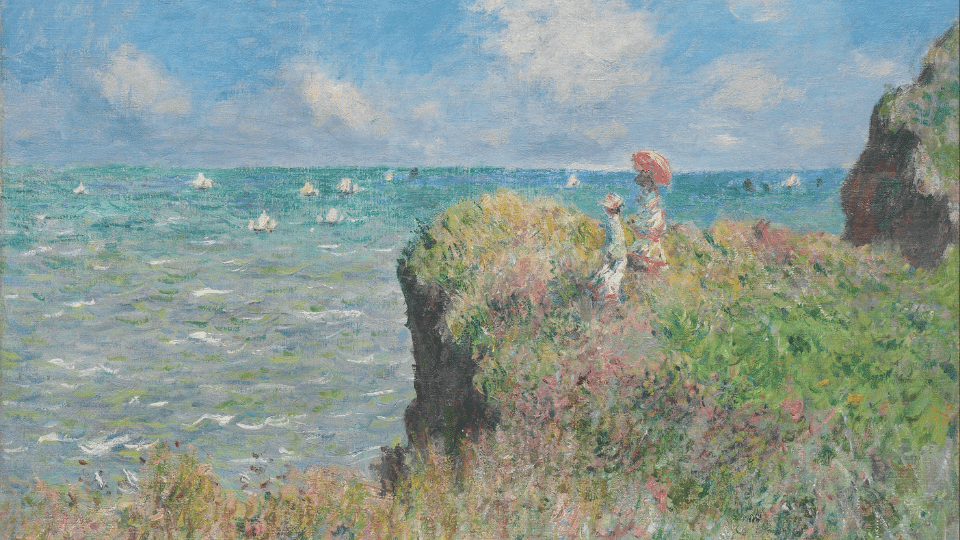
This dramatic seascape shows two figures walking along windswept cliffs overlooking the English Channel in Normandy, with Monet’s composition emphasizing the vastness of sky and sea.
Windblown grasses in the foreground create movement and depth, demonstrating his skill at depicting natural forces.
- Year: 1882
- Significance: This painting exemplifies Monet’s emotional connection to coastal landscapes throughout his career, conveying both the exhilaration and solitude of experiencing nature’s raw power and beauty.
11. The Train in the Snow
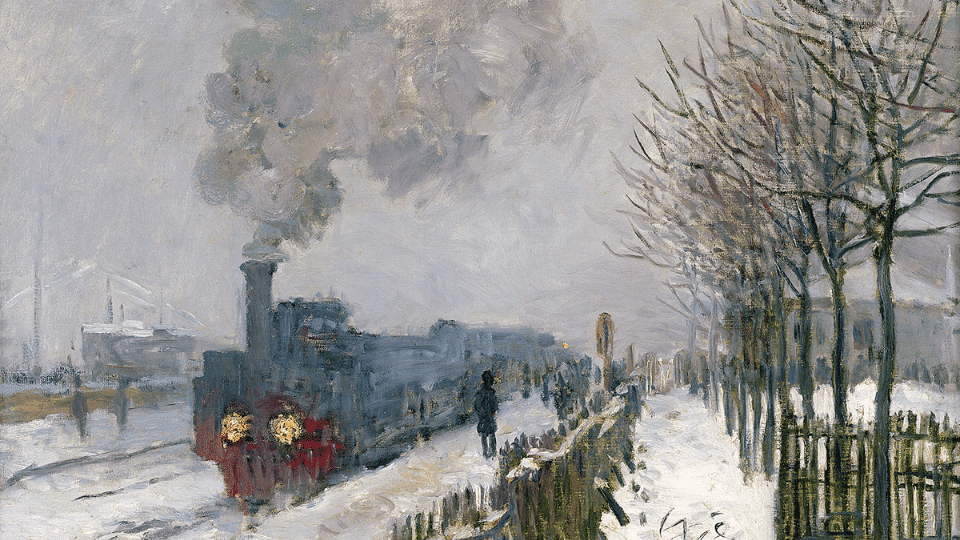
This painting depicts a steam locomotive arriving at a snow-covered train station, likely near Argenteuil, blending modern industrial subject matter with Impressionist techniques.
The snowy landscape reflects subtle colors, blues, purples, and pinks, demonstrating Monet’s understanding that snow isn’t simply white.
- Year: 1875
- Significance: This work represents the Impressionist commitment to painting modern life rather than just timeless pastoral scenes, finding beauty in industrialization through the harmonious contrast between powerful machinery and soft natural settings.
Other Works of Claude Monet
Beyond his most celebrated masterpieces, Monet created thousands of paintings throughout his six-decade career, ranging from early portraits and urban scenes to late abstract garden studies. Here are many of his other significant works that showcase his artistic evolution and diverse subjects.
12. The Luncheon on the Grass (1865-1866): A large-scale picnic scene featuring elegantly dressed figures dining outdoors under dappled forest light. Monet’s ambitious early work attempted to modernize classical themes with contemporary outdoor leisure activities.
13. Women in the Garden (1866): Four fashionable women in elaborate dresses gather in a sunlit garden, showcasing Monet’s early experiments with outdoor light. The painting was rejected by the Paris Salon, pushing Monet toward the Impressionist movement.
14. The Magpie (1868-1869): A solitary magpie perches on a wooden gate in a snow-covered winter landscape bathed in soft afternoon light. Monet masterfully captured subtle color variations in the snow, using blues, violets, and warm tones.
15. La Grenouillère (1869): This lively scene depicts a popular floating restaurant and bathing spot on the Seine where Parisians gathered for leisure. Monet painted alongside Renoir, using quick brushstrokes to capture shimmering water and fashionable crowds.
16. The Beach at Sainte-Adresse (1867): Vacationers stroll along a pebbled beach with fishing boats pulled ashore under a cloudy sky. The painting captures the growing popularity of seaside resorts among the French middle class.
17. Camille (The Woman in the Green Dress) (1866): Monet’s future wife Camille poses in an elegant emerald green dress with luxurious fabric folds and fur trim. This full-length portrait earned praise at the 1866 Salon and helped establish Monet’s early reputation.
18. The Bridge at Argenteuil (1874): The modern iron railway bridge spans the Seine with sailboats gliding beneath on sparkling blue water. Monet embraced industrial progress as part of contemporary life worthy of artistic celebration.
19. Regatta at Argenteuil (1872): Colorful sailboats race across the Seine with their reflections dancing on the water’s surface. The painting captures a moment of leisure and movement in the suburban town where Monet lived.
20. The Promenade at Argenteuil (1872): Figures stroll along a tree-lined path beside the Seine under dappled shade on a sunny afternoon. Monet painted the popular walking area near his home, celebrating everyday middle-class recreation.
21. Red Boats at Argenteuil (1875): Brightly painted pleasure boats rest along the calm Seine, their vivid red hulls glowing against shimmering reflections of houses and trees. Monet balances bold complementary colors, using the intense reds to energize the otherwise tranquil suburban riverside setting.
22. Autumn on the Seine at Argenteuil (1873): Golden autumn trees illuminate the riverbank while sailboats drift under a soft, glowing sky that hints at the quiet shift of seasons. The work captures the harmony of Argenteuil’s landscape and showcases Monet’s sensitivity to seasonal color transitions.
23. The Beach at Trouville (1870): Beach-goers relax on the sand at this fashionable Normandy resort, with flags fluttering in the coastal breeze. Monet painted quickly outdoors, reportedly getting sand mixed into his paint from the beach wind.
24. Terrace at Sainte-Adresse (1867): Family members relax on a seaside terrace overlooking the English Channel, with bright flowers in the foreground and sailing ships on the horizon. The composition combines Japanese-inspired flat areas of color with traditional perspective.
25. Stormy Sea in Étretat (1883): Dramatic waves crash against the Normandy coast under threatening gray skies, demonstrating nature’s raw power. Monet captured the turbulent energy of the Channel during winter storms.
26. The Manneporte near Étretat (1886): A massive natural stone arch rises from the sea, carved by centuries of waves along the Normandy cliffs. Monet painted this dramatic geological formation multiple times, fascinated by its monumental scale and changing light.
27. Belle-Île Series (1886): Monet spent ten weeks on this rugged Brittany island, painting its wild coastline and rock formations. The series showcases dramatic seascapes with crashing waves and windswept landscapes.
28. Haystacks (1890-1891): Monet painted approximately 25 views of haystacks in fields near his Giverny home under different weather and light conditions. Each painting transforms the simple agricultural subject into studies of color, atmosphere, and perception.
29. Poplars on the Epte (1891): Tall poplar trees line the Epte River, their slender trunks reflected in the water below. Monet painted about 24 canvases of these trees, rushing to finish before they were sold for timber.
30. The Three Trees (1891): Three prominent poplars dominate the composition with their graceful forms silhouetted against the sky and reflected in the water. The series explores rhythm, pattern, and the decorative qualities of nature.
31. The Seine at Giverny (1897): Morning mist rises from the Seine near Monet’s property, creating a dreamy, atmospheric scene. The soft focus and muted colors reflect Monet’s increasingly abstract approach to landscape.
32. Morning on the Seine Series (1896-1897): Monet rose before dawn to capture the river at sunrise, working from a specially designed floating studio boat. These misty, meditative paintings focus on subtle color harmonies and atmospheric effects.
33. Bathers at La Grenouillère (1869): Swimmers and boaters enjoy the popular Seine bathing spot, with dappled sunlight dancing across the water’s surface. The loose, sketchy style anticipated the Impressionist techniques Monet would fully develop.
34. Boulevard des Capucines (1873-1874): Pedestrians appear as dark marks moving along a busy Parisian boulevard viewed from an elevated window. The innovative aerial perspective and sketchy figures shocked traditional critics at the first Impressionist exhibition.
35. The Rue Montorgueil in Paris (1878): French flags hang from buildings lining a Paris street during a national celebration, creating vibrant patterns of red, white, and blue. Monet captured the patriotic excitement and energy of crowds celebrating a national holiday.
36. Saint-Lazare Station Series (1877): Monet painted about 12 views of Paris’s bustling train station, capturing steam locomotives, iron architecture, and modern urban life. The series found beauty in industrial subjects, showing billowing steam as atmospheric effects worthy of artistic study.
37. Spring Flowers (1864): A carefully arranged still life of vivid spring blossoms fills the canvas with gentle luminosity. Monet uses soft transitions of color to study natural beauty before fully embracing Impressionism.
38. Gladioli (1876): Tall gladiolus flowers rise confidently from an ornate vase, painted with bold, sure strokes. Monet uses intricate color contrasts and the interplay of warm and cool tones in the petals. This still life shows how floral subjects helped him refine his technique while supporting his income.
39. Chrysanthemums (1878): A dense bouquet of chrysanthemums expands outward with layered textures and saturated hues. Monet examines the flower’s complex forms through subtle gradations of light and shadow. These paintings combine artistic experimentation with practical financial necessity during hard times.
40. Iris Garden at Giverny (various): Sweeping beds of purple irises fill Monet’s garden, forming rhythmic waves of layered color. He eliminates fine detail to focus on patterns created by light passing over clustered blooms.
41. The Path through the Irises (1914 to 1917): A narrow garden path winds through towering irises painted with thick, atmospheric brushwork. Monet captures the quiet enclosure of his garden as a place of refuge during global conflict. The piece reflects emotional retreat and the meditative calm of nature during World War I.
42. Agapanthus Series (1914 to 1926): Blue and white agapanthus blossoms stretch across large canvases in sweeping, fluid strokes. Monet’s failing eyesight leads him toward increasingly adventurous and unconventional color use.
43. The Rose Bushes (1925 to 1926): Soft clusters of rose blossoms dissolve into shimmering fields of blended color and motion. Monet’s late technique replaces structure with expressive, energetic paint surfaces. These works demonstrate his near-complete shift toward abstraction in his final years.
44. Wisteria (1919 to 1920): Cascades of purple wisteria hang like curtains, forming decorative sweeps across the canvas. Monet reduces depth to emphasize surface rhythm, turning flowers into floating color veils.
45. Weeping Willow Series (1918 to 1919)
Weeping willows loom in swirling, intense strokes that convey emotional heaviness and unrest. Monet channels grief over wartime losses into dark palettes and expressive movement. The series stands as a powerful symbol of mourning framed through the tranquility of nature.
46. Japanese Footbridge Series: Monet’s beloved wooden bridge appears in thick layers of vibrant paint that verge on abstraction. His cataracts shift his color perception, pushing him toward fiery tones and dense textures. These later works mark a radical transformation, showing nature filtered through altered vision.
47. Winter Scene at Argenteuil (1875): Snow-covered roofs, leafless trees, and quiet streets create a serene suburban winter atmosphere. Monet reveals the hidden colors within snow through delicate blues, violets, and softened tones.
48. Frost (1880): A layer of frost transforms the morning landscape into a crisp tapestry of shimmering light. Monet captures the fragile beauty of frozen grasses and pale winter air with heightened precision. The painting reflects his fascination with seasonal transitions and subtle atmospheric effects.
49. Ice Floes (1880): Chunks of broken ice drift along the frozen Seine, creating sharp contrasts against dark water. Monet studies this rare winter phenomenon with careful attention to light bouncing off icy surfaces. The work shows his willingness to learn in challenging, fleeting conditions in pursuit of the truth.
50. Springtime (1886): Blossoming fruit trees and vibrant green fields announce the renewal of spring in full bloom. Monet paints the landscape with a joyful palette that captures the freshness of the air and the expanding light.
51. Garden at Sainte-Adresse (1867): This vibrant early work shows a seaside garden terrace at Sainte Adresse, planted with bright flowers overlooking the sparkling waters of the English Channel. Figures in elegant summer attire relax while sailboats glide across the horizon.
Themes and Techniques in Monet’s Paintings
Claude Monet’s philosophy centered on capturing fleeting light and its effects on nature, emphasizing plein air painting to record specific moments under specific lighting conditions and working swiftly before atmospheric conditions changed.
- He used broken brushstrokes and unmixed colors to mimic how the eye perceives shifting light, creating vibrant and dynamic compositions.
- Monet avoided black for shadows, instead using blues, purples, and greens to create depth and maintain color vibrancy throughout his canvases.
- His obsession with reflective surfaces, especially water, shaped his exploration of light and movement as he studied how landscapes doubled and distorted in ponds and rivers.
- These techniques revealed that reality is fluid and subjective, allowing him to transform perception through color and atmosphere.
Through these innovative methods, Monet turned ordinary scenes into timeless masterpieces that continue to influence how we understand light, color, and the ever-changing nature of visual experience.
Where to See Claude Monet’s Paintings Today
Claude Monet’s famous paintings are housed in major museums worldwide, with the largest collections in French and American institutions, though notable works also appear across Europe, Asia, and beyond.
Key Museums and Galleries:
- Musée d’Orsay, Paris: Houses an extensive collection of Impressionist works, including multiple Monet paintings from various periods of his career
- Musée de l’Orangerie, Paris: Features Monet’s monumental Water Lilies panels in two specially designed oval rooms, creating an immersive viewing experience
- Musée Marmottan Monet, Paris: Holds the largest collection of Monet’s works worldwide, including “Impression, Sunrise” and numerous paintings from his personal collection
- The Metropolitan Museum of Art, New York: Displays several iconic Monet works across its European paintings galleries
- The National Gallery, London: Features important Monet landscapes and water lily paintings
- Art Institute of Chicago: Contains a significant collection of Monet’s works, including pieces from his famous series
For in-person visits, arrive early to avoid crowds at museums like the Musée d’Orsay and view paintings from different distances to see how Monet’s brushwork reveals varying details, or explore online collections and visit his restored home in Giverny for context on the landscapes that inspired his famous series.
Final Brushstroke
Claude Monet’s famous paintings continue to inspire art lovers more than a century later. His techniques helped launch the Impressionist movement and changed how artists approached their craft.
Each brushstroke taught future generations that personal perspective matters as much as technical skill. From peaceful gardens to bustling city scenes, his collections offer something for every taste.
Learn about his work closely; his unique vision might change how you see the world around you.

